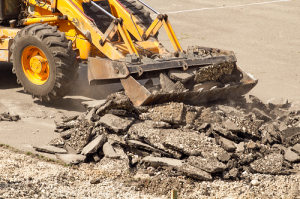The construction industry is an incredibly resource-heavy industry. In the U.S., construction and demolition generates over 600 million tons of waste debris annually. A significant amount of this waste ends up in landfills, burdening cities and the environment.
If you run a construction business, these figures are probably not surprising to you. Partnering with Junk King Sonoma as part of your waste management strategy could ease some of your burdens. Getting rid of construction waste and debris is time-sensitive and can be costly. Concrete, wood, and steel are not easy materials to haul away.
At Junk King, we go out of our way to sort out these issues for you. We provide cost-efficient and eco-friendly construction debris removal services. You’ll most likely require our services several times during a project. As such, we ensure our services are timely and efficient, allowing you to do your job better.

We Responsibly Dispose of Your Construction Debris, so You Don’t Have To
Here’s how construction debris removal with Junk King works:
- Schedule an appointment. Book online, call, or text us.
- We arrive on time for the scheduled appointment and give you an estimate based on how much volume your junk occupies in our trucks.
- We haul the construction waste from your site.
So, what happens to the construction debris once it leaves your site? Junk King Sonoma has partnered with recycling facilities throughout the city so your waste doesn’t end up in a landfill. A few of the common construction materials that can be easily recycled include:
- Concrete
- Corrugated iron
- Drywall
- Steel
- Wood
- Plastic
- Glass and asphalt
We haul away almost all types of construction and demolition debris. Some items we donate to charity include:
- Brick
- Siding
- Tools
- Roofing tiles
- Wood
- Floorboards
- Tiling
- Windows and doors
Our philosophy is to recycle and donate as much as we can from the waste we haul. From small residential renovations to major home additions and commercial projects, call Junk King Sonoma for easy construction debris removal.
Why Junk King Sonoma?
Construction debris adds up quickly in terms of both size and weight. Now this can significantly hamper the progress of your project. But fret not; with Junk King, you don’t have to worry about any of this. Let’s look at a few reasons why Junk King Sonoma is your ultimate construction waste removal partner.
-
We can drop off a dumpster
It’s important to sort and separate your construction waste, especially if you’re going after LEED Certification. A dumpster rental service may be exactly what you need to achieve effective waste separation. Whether you run a construction business or doing a home remodel on your own, our MINI dumpsters can see to it that your construction debris never gets out of hand.
Junk King MINI dumpsters can hold up to 12 cubic yards of waste. And our fair and transparent pricing policy still holds when it comes to dumpster rental. We’ll only charge you for the amount of space that you actually use.
So, call Junk King Sonoma today for a flexible, convenient solution to your construction waste management. And the best part? We haul that dumpster bag away for you and drop it off again – all at an agreed-upon schedule.
-
Compliance and Safety
It’s no secret that construction sites are hazardous. Improper management of construction debris can lead to injuries and other workplace safety hazards. Like you, Junk King places a strong emphasis on compliance and safety in all aspects of our operations. Our team is fully licensed, bonded, and insured for this exact reason.
Furthermore, we ensure our junk specialists are fully trained. You can rest assured that we adhere to all local waste removal regulations. With us, your construction waste management needs will be handled professionally, responsibly, and in a time-friendly manner.
-
Efficiency and convenience
The Junk King crew runs like a well-oiled machine. We understand that construction projects are incredibly time and budget sensitive. That’s yet another reason why we work according to your schedule. You can call us at any time for construction debris removal, or we can work together to develop a customized waste-hauling plan that adheres to your project timelines.
Once we have everything scheduled, our junk removal specialists will work to ease some of your project’s junk management stresses. We’ll arrive on site promptly, equipped with all the necessary tools and materials to get rid of your construction waste.
-
Commitment to environmental sustainability
We purpose to divert waste from landfills. After we haul away your waste, our junk removal team will carefully sort and separate the construction debris to ensure every material is recycled effectively. These materials are then transported to specialized recycling centers, where they can be repurposed for new construction projects.
What’s more, we strive to stay up to date on the latest developments in construction waste management. This way, we can stay committed to environmental stewardship and contribute to a greener, more sustainable future.
-
Excellent Service on Any Job
Did we mention our customer service is like no other? Call us today to find out why we’re the number one-rated junk removal company in North America. We guarantee the best service in the industry and can beat any written estimate.
Trust Junk King Sonoma for All Your Construction Debris Removal Needs
Let’s take the stresses of construction debris removal off your hands. We’re the efficient, eco-friendly solution you’ve been looking for. Same-day and next-day services are available for those last-minute situations. Contact us today to ensure your construction project runs smoothly.
 Text Us
Text Us




 The process of cleaning out your home can involve a mini dumpster rental because, simply put, not everything is going to be easy to sell. While selling things and taking in some quick cash sounds like a great idea, sometimes the execution is not that simple. Mini dumpster rental makes it tremendously easier to get rid of items that you have had for a long time, but that it seems like nobody else wants. This is especially the case for mattresses, which have a tendency to get very dirty over the years and that carry a skeavy vibe for most people. Renting a
The process of cleaning out your home can involve a mini dumpster rental because, simply put, not everything is going to be easy to sell. While selling things and taking in some quick cash sounds like a great idea, sometimes the execution is not that simple. Mini dumpster rental makes it tremendously easier to get rid of items that you have had for a long time, but that it seems like nobody else wants. This is especially the case for mattresses, which have a tendency to get very dirty over the years and that carry a skeavy vibe for most people. Renting a 


 Junk disposal is part of the decluttering process that focuses on disposing of junk the right way. In America, junk disposal is a growing segment of the cleaning industry,
Junk disposal is part of the decluttering process that focuses on disposing of junk the right way. In America, junk disposal is a growing segment of the cleaning industry,  Demolition encompasses the destruction of a building in such a way that the components are not fit for reuse. Deconstruction, on the other hand, involves the dismantling of structures with the aim of reusing most of the parts. The latter is more recommended because it reduces the amount of wastes that end up in the landfill. It also saves you from the hassle of recycling the gathered debris to come up with reusable parts.
Demolition encompasses the destruction of a building in such a way that the components are not fit for reuse. Deconstruction, on the other hand, involves the dismantling of structures with the aim of reusing most of the parts. The latter is more recommended because it reduces the amount of wastes that end up in the landfill. It also saves you from the hassle of recycling the gathered debris to come up with reusable parts. Here are some of the facts related to construction and demolition for which you need to be aware of –
Here are some of the facts related to construction and demolition for which you need to be aware of – In California, construction and demolition debris includes:
In California, construction and demolition debris includes: There is some safety risk involved in handling leftover construction materials such as glass, iron,
There is some safety risk involved in handling leftover construction materials such as glass, iron, 